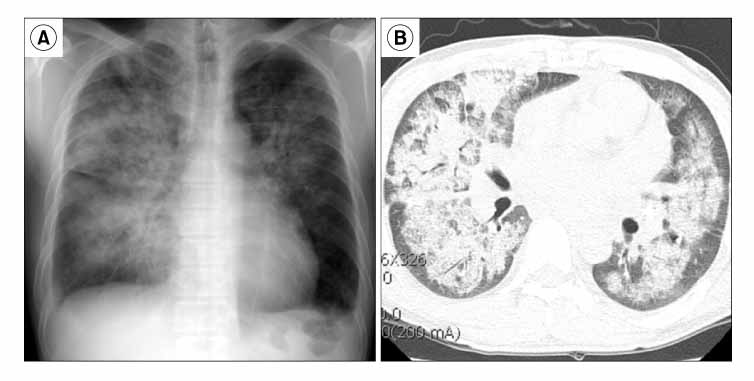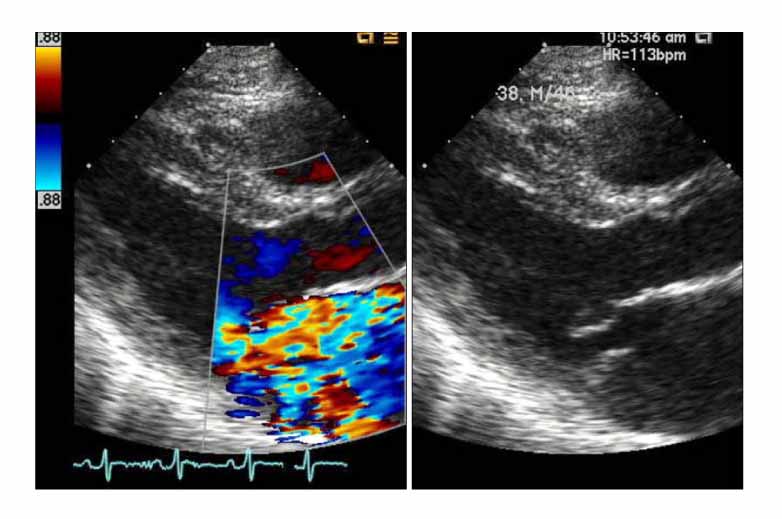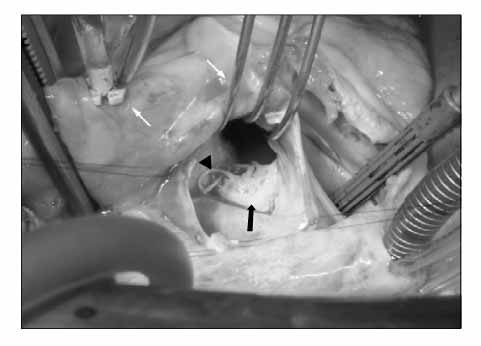Tuberc Respir Dis.
2007 Nov;63(5):458-461. 10.4046/trd.2007.63.5.458.
A Case of Pulmonary Edema by Idiopathic Rupture of Mitral Chordae Tendinae
- Affiliations
-
- 1Department of Internal Medicine, Inje University College of Medicine, Paik Hospital, Seoul, Korea. choisj@sanggyepaik.ac.kr
- 2Department of Chest Surgery, Inje University College of Medicine, Paik Hospital, Seoul, Korea.
- 3Department of Radiology, Inje University College of Medicine, Paik Hospital, Seoul, Korea.
- KMID: 2050482
- DOI: http://doi.org/10.4046/trd.2007.63.5.458
Abstract
- The typical radiographic findings of pulmonary edema from the increased hydrostatic pressure shows centrally localized consolidation, which is known as a "butterfly or bat's wing" pattern. These terms describe the anatomic distribution of edema that uniformly involve the hilum and medulla of the lung but not the peripheral region of the lung parenchyma (cortex). We present a case of butterfly wing-like pulmonary edema on a chest radiograph by mitral regurgitation due to an idiopathic chordal rupture.
MeSH Terms
Figure
Reference
-
1. Ku JM, Chung JW. Lim JK, Lee KS, editors. Chapter 9 Pulmonary edema and hypertension. Thoracic radiology. 2000. Seoul: Ilchokak;303–316.2. Fraser RS, Muller NL, Colman NC, Pare PD, editors. Chapter 51 Pulmonary edema. Fraser and Pare's diagnosis of diseases of the chest. 1999. 4th ed. Montreal: Saunders;1958–1973.3. Gurney JW, Goodman LR. Pulmonary edema localized in the right upper lobe accompanying mitral regurgitation. Radiology. 1989. 171:397–399.4. Schnyder PA, Sarraj AM, Duvoisin BE, Kapenberger L, Landry MJ. Pulmonary edema associated with mitral regurgitation: prevalence of predominant involvement of the right upper lobe. Am J Roentgenol. 1993. 161:33–36.5. Young AL, Langston CS, Schiffman RL, Shortsleeve MJ. Mitral valve regurgitation causing right upper lobe pulmonary edema. Tex Heart Inst J. 2001. 28:53–56.6. Grenon H, Bilodeau S. Pulmonary edema of the right upper lobe associated with acute mitral regurgitation. Can Assoc Radiol J. 1994. 45:97–100.7. Alarcon JJ, Guembe P, de Miguel E, Gordillo I, Abellas A. Localized right upper lobe edema. Chest. 1995. 107:274–276.8. Singh R, Schrank JP, Nolan SP, McGuire LB. Spontaneous rupture of mitral chordae tendinae. JAMA. 1972. 219:189–193.
- Full Text Links
- Actions
-
Cited
- CITED
-
- Close
- Share
- Similar articles
-
- Chordae Rupture and Acute Mitral Regurgitation Associated with Infective Endocarditis in a Patient Undergoing Hemodialysis
- Clinical Characteristics and Trends of the Surgical Treatment of Chordae Rupture
- Asymmertric atypical pulmonary edema from the rupture of the mitral valve chorda tendineae
- Operative Treatment of Mitral Valve Regurgitation Due to Chordal Rupture and/or Papillary Muscle Rupture
- Musical murmur in a dog with acute chordae tendineae rupture





